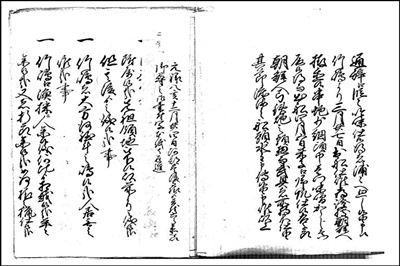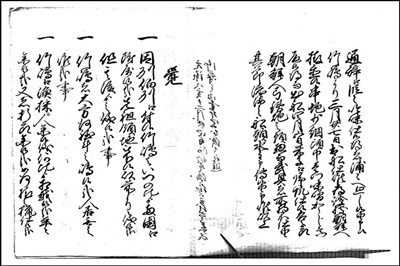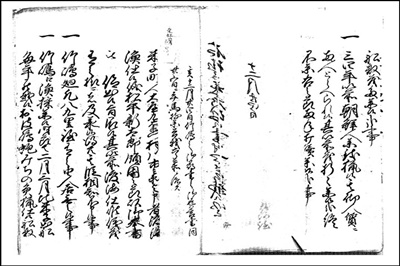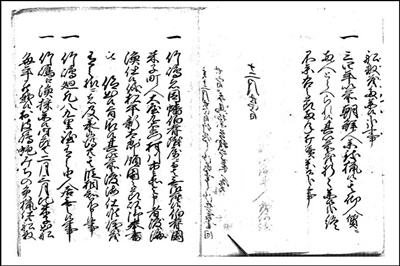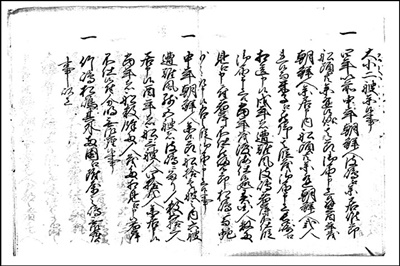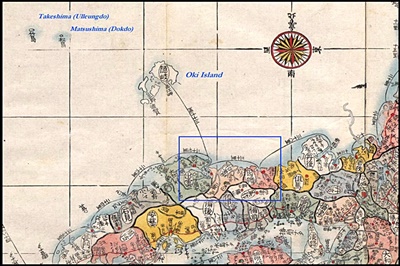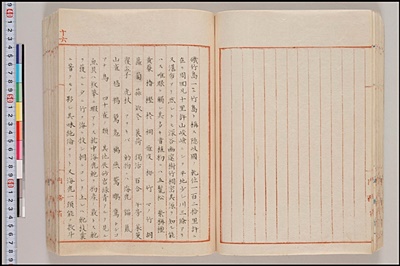因幡??伯耆?に附?している竹島は、いつ頃から??へ附?していたのか。先祖(池田光仲)が領地として?えられる年以前からのこ
とであるのかあるいはその後からのことであるのか1632
竹島は、どれくらいの大きさの島であるのか。人が暮らしてはいないのか。
竹島へ漁採のために行くのは、いつ頃出?するのか。?年、行っているのか。
または、時折行くのか。どんな?をしているのか。船?も多く行っているのか。
3、4年以前、朝鮮人がやって?て、?をしている。その時、人質として2人を捕らえた。
それ以前も時??ていたのか。?たことはなく、2年間?いて?たのか。
この1、2年は?ていないのか。
先年、行った時には、船?はどれくらいであったか、人もどれくらい?ていたのか。
竹島のほかに、??(因幡?伯耆)に附?する島はあるのか。また、??の者が、そこで漁??採集を行っているのか。
右の事項について、知りたい。書面で提出しなさい。以上。
An English Translation of the 1695 Records
2. “…What is the size of the island Takeshima (Ulleungdo)? Is it inhabited by people..?”
3. “…When is the departure time for its marine products of Takeshima (Ulleungdo)? Are they going every year or occasionally? What do they hunt? Are there many ships going there..?”
4. “…Three or four years ago, Koreans were found hunting there, and two of them were taken as hotages. Had Koreans sometimes been there even before that time? Or they hadn’t it been that way for two years..?”
5. “…Have they been there for the last two years..?”
6. “…When was the trip made last year? how many boats were there? And how many people were there..?”
7. “…Besides Takeshima (Ulleungdo) are there any other islands that are within the two areas jurisdiction? Do citizens from these two areas exercise their fishing and gathering on the island..?”
Inbashu’s Response to the Shogunate Regarding Ulleungdo and Dokdo
竹島は、因幡?伯耆に附?してはおりません。伯耆?米子町の人、大谷九右衛門、村川市兵衛と申す者が、
海を渡って漁をしているのは、松平新太?(池田光政)が(因幡?伯耆を)領?としていた時( 1617-1632年)、 御奉書(幕府老中が?行した文書)によってご指示があったと聞いております。それ以前に渡海し
ていたこともあるように聞いておりますが、そのことについては知りません。
竹島の周?は、約8~9里程度とのことで、人は暮らしておりません。
竹島へ?採に行く時期は、2月、3月頃、米子から船出します。?年行っております。あの島で??みち
アシカ)の?を行います。船?は大小2?で行きます。
4年以前申年に朝鮮人があの島へやって?た時船頭たちが朝鮮人と逢ったことはその時
ご連絡しております。翌酉年も朝鮮人がきていましたので、船頭たちは逢い、朝鮮人2人を連れ、米子へ?り
ましたが、その時もご連絡し、長崎へ送りました。戌年は、難風に遭い、あの島へ着岸しなかったことはご連
絡しております。今年も、渡海しましたが、異?人が?多く見えたため、着岸せずに?る際、松島で?を少?
採りました。右のことはご連絡しております。
申年に朝鮮人がやって?た際は、11?の船のうち6?が難風に遭い、?り5?があの島に留まり、53人
がいました。酉年は、船3?、人が42人?ておりました。今年は、船?が多く、人も多く見えました。着岸
しなかったので、はっきりしたことはわかりません。
竹島、松島、その他、??(因幡?伯耆)に附?する島は、ありません。
<この間、幕府から鳥取藩に?し、「松島」に?する問い合わせがあったと考えられる>
A Translation of the 1695 Response to the Shogunates Inquiry
2. “…The island is about 8 or 9ri (36kms) around and there are no inhabitants…”
3. “…The hunting and gathering season starts around February and March and departs from Yonago. They go every year, gather abalone and hunt sealions. They use two boats, big and small…”
4. “…Four years ago, Chosun people came to the island and encountered our fishermen and it was recorded as such at the time. The next year, Chosun people kept coming and our fishermen confronted them and took two of them to Yonago and that incident was also recorded, they were sent to Nagasaki…”
5. “…The following year, due to terrible winds little attention was given to the island which is also reported. This year, voyages have been made again but many foreigners were seen therefore they paid little to the island and left. On the way back they caught abalone on Matsushima…”
6. “…Four years ago, when the Chosun people came they arrived in 11 boats, six of them met with terrible winds and the remaing five boats stayed on the island (Takeshima) including 53 people. The following year 42 people came on 3 boats. This year, since there are many boats there appear to be people as well. So little attention was paid and not much else is known…”
7. “…There are no other islands belonging to the two prefectures including Takeshima (Ulleungdo) and Matsushima (Dokdo)…”
Tottori (Shimane) Prefecture Records Some Maps for Locational Reference
The map below right is a close up of Shimane (Tottori) Prefecture showing exactly where the Japanese voyages to Takeshima and Matsushima originated from. From the records above we have learned that these yearly trips departed from Yonago City. Yonago is labeled upside down (米子) and can be seen as part of Hoki Province (伯耆) which is colored pink. Next, to Hoki is Inaba Province (因幡) colored in red. (click maps for larger image)
Japan’s 1877 Investigation of Ulleungdo – A Record of Japan’s 17th Century Voyages
Japan’s Kobunruko Documents from 1877
A Translation of Japan’s 1877 Inquiry’s About Ulleungdo and Dokdo’s Historical Background
Plants which catch one’s eye are goryo pines, rose wood, amur cork tree, camellia, oak, paulownia, Wikstroemia sikokiana, southern Japanese hemlock, bamboo, mano bamboo, wild carrot, longstamen onion, Japanese butterbur, Japanese ginger, udo, lily, edible burdock, cherry elaeagnus, raspberry, giant knotweed, Japanese aucuba.
Animals are sea lion, cat, rat, varied tit, pigeon, wild duck, brown-eared bulbul, oriental greenfinch, wild duck, cormoant, swallow, golden eagle, eagle, hawk, nadikoana(?) bird, great tit, and so on. Also found are cinnabar and malachite.
Fishes and shellfishes are too many to enumera. (The island) yields sea lions and ear shells. To catch ear shells, in the evening, input bamboo into the sea, and in the morning, ear shells are on the leaves of the bamboo. It is said that the taste is very good. And (we can) obtain several 斗’s(unit of the volume) oils from a sea-lion.
Next, there is “another island” called 松島 (Matsushima). The circumference is 30 Jung( 町), It is on the way to 竹島 (Ulleungdo). The distance from Oki is 80 Ri(里). Trees and a bamboos are rare. (The island) yields fishes and sea lions, too.
During 永? period, a merchant, 大屋甚吉 (Ohya Jinkichi) [Later, he changed his name to 大谷], who lived in 伯耆國 會見郡 米子町 (present Yonago city in Tottori prefecture) was hit by typhoon on the way back from 越後 (Echigo; Niigata prefecture), and drifted to this place. (He) investigated the whole island and noticed that there are a lot of fishes and shellfishes. After returning home, (he) asked the Investigator, Abe Shirogoro who was staying in Yonago Castle by order of Shogunate, to allow him to visit there. Abe asked it to Edo, and received a letter of permission on May 16 of the 元和 4 year (1618)… “
The True Nature of Japanese Voyages to Ulleungdo and Dokdo
 On the right side is the Japanese record of the permission to voyage to Takeshima (Ulleungdo) the Oya and Murakawa families received. It reads as follows:
On the right side is the Japanese record of the permission to voyage to Takeshima (Ulleungdo) the Oya and Murakawa families received. It reads as follows:
“..We have heard that a voyage was made from Hoki Province’s (伯耆) Yonago (米子) to Takeshima (Ulleungdo) in a previous year, which has led to a desire to go again. Concerning the application of Murakawa Ichibee and Oya Jinkichi of Yonago, we have spoken to the Shogun, and he listened to the request without seeming to have any objection and has granted their request. Therefore, I humbly convey this to you.
May 16 (1618)
Nagai Sinanonokami Naomasa
Inoue Kazuenokami Masatsugu
Doi Ohinokami Toshikatsu
Sakai Utanokami Tadayo
To Matsudaira Shintaro (Feudal lord of Tottori domain)…”
Notice this permission was just for voyage and not land being granted nor “feudal tenure” as some Japanese now assert.
The above session was conducted immediately before the Roju Abe, Bungono-kami sanctioned the official note from the problem of Ulleungdo Island in 1696 and it is believed to have influenced the decision of the Shogunate government. The official note states that “…from the beginning the island was not taken from Chosun by force and it does not make sense that it will be returned to Chosun…” and it acknowledges Takeshima as Chosun’s inherent territory from ancient times. This is precisely on this grounds that the Shogunate reversed its very decision in three years.
Therefore, no historical data shows that the Shogunate government consciously distinguished Takeshima (Ulleungdo) from Matsushima (Dokdo) and that Matsushima was understood to be an island attached to Takeshima (Ulleungdo). This must have been the generally accepted idea of that time.

